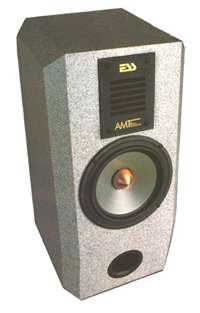Are Wide Bands Optimal?
|
A wideband is more like a narrowband compared to multi-way designs. It is a minimum phase system, but one with a very narrow quasi-linear frequency response. And it is also - at least on rough inspection - a point source, but one with often very uneven radiation characteristics. A full-range driver, however, is free of the usual phase and impulse problems that otherwise occur in the transition regions of drivers. There are limitations:
Full range drivers have great difficulties especially at the ends of the frequency range. They are not really powerful bass speakers. The limited linear excursion and the relatively small diaphragm area seldom allow a significant extension of the bass response at low frequencies, especially if you exceed room volume. |
Full-range drivers usually have not only a powerful drive, but also very light diaphragms. This results in the stated very high efficiency at a given frequency. Considered over the entire bandwidth, however, the efficiency is already significantly lower! High efficiency due to often short voice coils and light paper diaphragms also leads to non-linear excursion with strong distortions and, due to the diaphragm, to an early uneven drop of the dynamic phase.
Lightweight diaphragms are also not very stiff, resulting in so-called partial oscillations. These are the result of partial diaphragm vibrations, in which the diaphragm breaks down into many small partial areas, each of which vibrates separately. They each have their own acoustic centre. It is therefore not a pure point source. Due to these acoustic centers distributed on the membrane, which also vary in time, time-shifted, chaotic sound additions and subtractions are generated, which as interferences lead to unevenness in the frequency response.
Flat diaphragm loudspeakers as in the Myro Spirit IV are still the most suitable for a broadband application. The resonance phenomena are in the upper high frequency range and are often perceived by the listeners "only" as lively highs. On the other hand, the advantages of a much deeper coupling to the mid-woofers than with the usual tweeters outweigh the disadvantages, which ensures a more benign vertical dispersion behaviour of the overall system.
|
The transient A time aligned loudspeaker should have a fast transient tweeter, which can already reproduce the first half wave correctly. This requires a high resonant frequency. So far the Accuton diamond tweeters offer the best characteristics. But the full range driver behaves the other way round. If one looks at its frequency response, one sees besides a quite smooth course in the midrange to increasing ripple in the high frequency range. These are resonances, which produce the high frequency level. As with all resonances, this is unmodulated sound that contains no musical information. Wide-range drivers therefore hardly reproduce any music in the high-frequency range, but a chaotically generated mixture of frequencies. The useful bandwidth available for music is therefore much smaller than the frequency response indicates! Accordingly, one has the impression that there is no lack of high frequency level, but there is a lack of resolution. It has to be noted that the frequency response shown in the data sheet is often smoothed, so the ripple is even more pronounced in real measurements. Due to the inertia of the diaphragm and the development of high frequency resonances, a very poor reproduction of the first wavefront is to be expected in the high frequencies. Radiation under angle |
<zurück: Myroklopädie>
<zurück: Myro>

